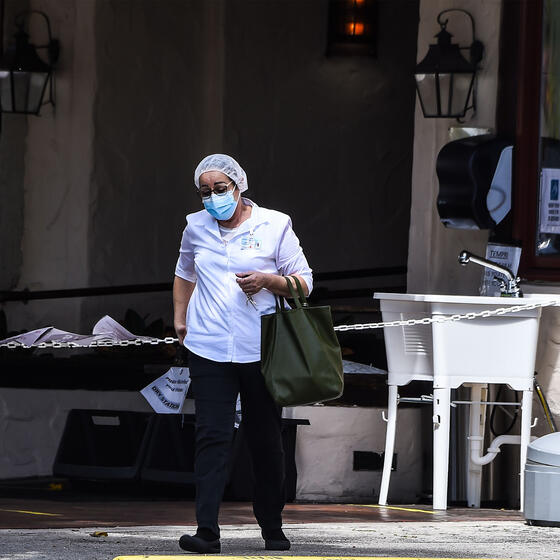Smartphone Data Shows How Shared Staff Spread COVID-19 through Nursing Homes
COVID-19 infections have spread rapidly through nursing homes despite a ban on visitors to the facilities. A new study co-authored by Yale SOM’s Judith A. Chevalier finds one likely explanation: staff members who work at multiple nursing homes. Using smartphone location data, the authors find that the movement of people among the facilities is associated with increased infections. They estimate that banning shared staff could reduce infections by 44%.

A staff member outside Fair Havens Center nursing home in Miami Springs, Florida, in May 2020. Fifty-four residents of the nursing home have died from COVID-19. Photo: Chandan Khanna/AFP via Getty Images.
Nursing homes and other care facilities in the United States have been devastated by COVID-19, accounting for nearly half of all U.S. deaths from the pandemic. Infections have spread despite a ban on visitors to the facilities imposed by the Centers for Medicare and Medicaid Services (CMS) in March.
A new study co-authored by Yale SOM’s Judith A. Chevalier, using smartphone location data to track movement between the facilities, suggests that one source of the spread of infections is staff who work in multiple nursing homes. Banning such shared staff could reduce infections in the facilities by 44%, the authors find.
The study, co-authored by M. Keith Chen and Elisa F. Long of the UCLA Anderson School of Management, draws on location data from 30 million smartphones between March 13, when the ban on visitors began, and April 23. The authors paired the location data with nursing home addresses and satellite building images to track when smartphones entered nursing homes. They found that about 500,000 smartphones entered a nursing home at some point, and 7% of those entered more than one. While the smartphone location data was anonymized, the individuals moving among nursing homes after the visitor ban were most likely staff. Previous studies have found that many nursing home staff work at multiple facilities, the authors note, because they work through a staffing agency, because they supplement their income with additional jobs, or because they are independent clinicians or technicians.
“A major challenge facing nursing homes is that every connection is a potential link to other connections—and to SARS-CoV-2 transmission.”
The researchers used the location data to create network maps, showing how people moving among nursing homes created connections among them. “A major challenge facing nursing homes is that every connection is a potential link to other connections—and to SARS-CoV-2 transmission,” the authors write.
In Connecticut, for example, one nursing home that suffered a large COVID-19 outbreak of 102 cases was linked to six other facilities through the movement of one smartphone in each pairing, a relatively low number of connections compared to its peers. But those six facilities were connected to many more nursing homes, multiplying the potential exposure of the facility at the center of the network.
And, indeed, the researchers found that such network connections were predictive of more infections, controlling for location, demographics, size, and quality ratings. An additional 10 direct connections were associated with a 26.7% increase in COVID-19 infections; indirect connections, measured in various ways, were also associated with increased cases. Compared to a completely unconnected nursing home, the most connected nursing home in any given state was expected to have an increase of cases of 190%.
The potential role of shared staff in spreading COVID-19 has been understood since early in the pandemic, the authors point out. The Centers for Disease Control reported on March 18 that such staff were a likely factor in the spread of infections among facilities in Washington State. But no regulation limiting shared staff has been issued.
“Absent such regulation, allocation of PPE, testing, and other preventative measures should be targeted thoughtfully, recognizing the current potential for cross-transmission across [nursing] homes,” the authors write.
This research was supported by Yale’s Tobin Center for Economic Policy.